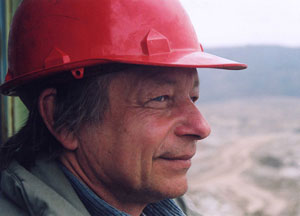An international research team has reconstructed the climate of Europe over the past 45 million years using the palaeobotanical record of well-dated fossil leaves, fruits, and seeds, and showed how it evolved from tropical to seasonal. Their findings could have important implications for our understanding of climate change and how human activities might be affecting it.
Volker Mosbrugger of the Institute of Earth Sciences at Tuebingen, Torsten Utescher of the Geology Institute in Bonn, Germany, and David Dilcher of the Museum of Natural History, in Gainesville, Florida, USA, have obtained inferred data on mean annual temperature and precipitation for Central Europe for the so-called Cenozoic period. Although they saw some regional effects occur, their study of the continental climate record correlates well with data based on the global oxygen isotope record from marine environments.

David Dilcher
According to Dilcher and his colleagues, oxygen isotope records from ocean sediment cores have allowed climatologists to reconstruct in detail ocean water temperature changes and so provide insight into ice volume changes and fluctuations in climate. However, this information does not stretch to the European continental Cenozoic climate and only a few researchers have tried to correlate this region with the marine data. As such, scientists cannot be sure that their climate models for the Cenozoic are actually valid, which has important implications not only for understanding the climate of the past but predicting that of the future.
The new data show that during the last 45 million years, cooling of continental Europe is especially pronounced for inferred winter temperatures but is not associated with observable summer temperatures. In other words, the gradual Cenozoic cooling of Central Europe is associated with an increase in seasonality – a shift from the tropical climate to the summer-winter cycle of present-day Europe.

Volker Mosbrugger
On the other hand, the data also suggest that average annual precipitation was fairly constant, which hints at how important precipitation is in latent heat transport throughout this geological period as water evaporates and condenses. The researchers also note that although there were small changes in atmospheric carbon dioxide levels, and that these were linked to changes in climate, falling levels were not the major driving force for Cenozoic cooling, since there were no major drops in carbon dioxide during that time.

Torsten Utescher
In the context of human-induced climate change palaeoclimate studies are important to analyze the natural range of climate variations occurring in the past, explains Utescher. In addition, the analysis of past climates is crucial when testing the reliability of General Circulation Models that are used to explain the processes behind and to predict future climate conditions.
Further reading
Proc Natl Acad Sci (USA), 2005, in press
http://www.pnas.org/cgi/doi/10.1073/pnas.0505267102
David Dilcher
http://www.flmnh.ufl.edu/directory/cvs/dilcher_cv.htm
Torsten Utescher
http://www.sfb350.uni-bonn.de/Wob/de/view_content/class46_id65.html
Palaeoflora database
http://www.palaeoflora.de/
NECLIME homepage
http://www.neclime.de/
Suggested searches
climate change
palaeoclimate